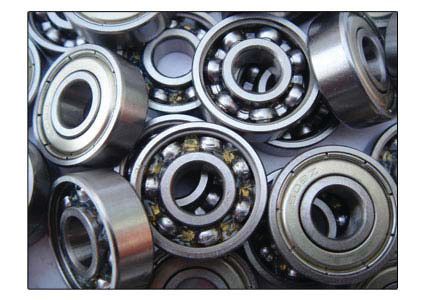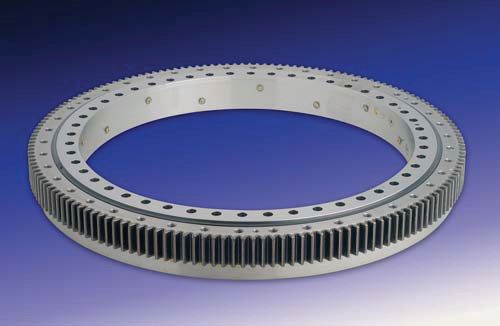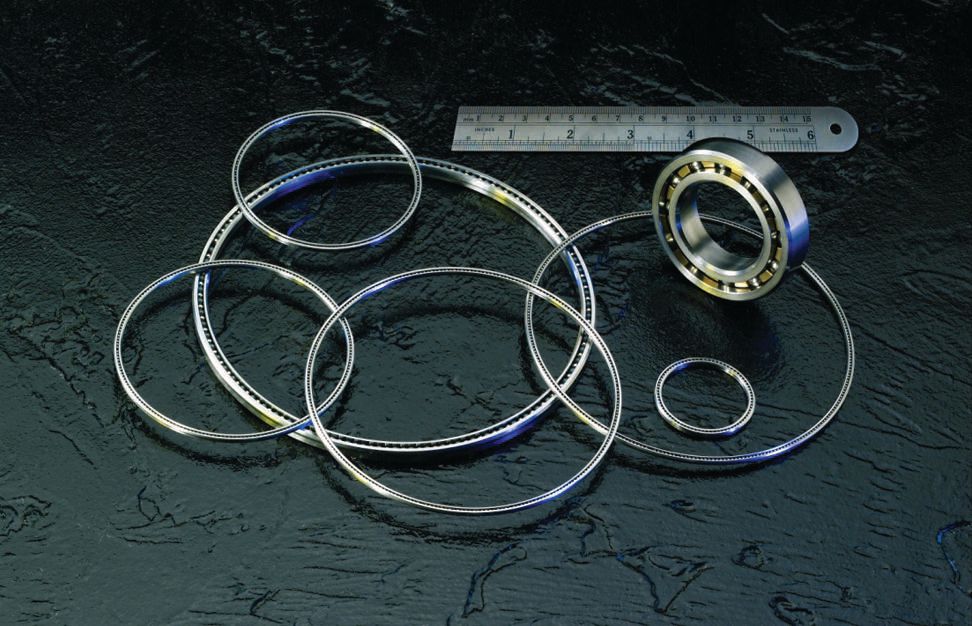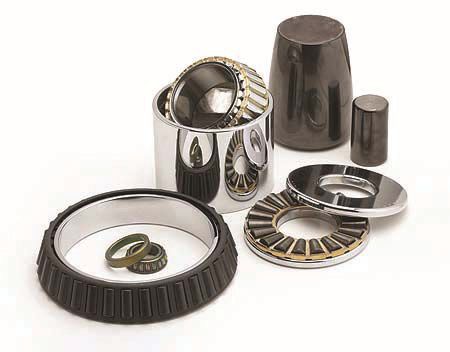Key trends in bearing lubrication
Dr. Neil Canter, Contributing Editor | TLT Cover Story April 2012
Armed with new materials, manufacturers are developing energy-efficient bearings for specific applications.
KEY CONCEPTS
•
Advancements in materials have extended the operating life of bearings, even under severe operating conditions.
•
New additives enable bearing lubricants to be designed and developed for specific applications.
•
Future bearing materials will need to boost performance and improve efficiency.
BEARINGS ARE VERY USEFUL IN FACILITATING the efficient operation of machinery (
see Figure 1). They can range in size from a large diameter wind turbine blade-pitch bearing to a series of thin bearings (
see Figures 2 and 3).
 Figure 1. Bearings are used to reduce friction, support a load, promote the efficient transmission of power and ensure alignment in machinery is maintained. (Courtesy of Bearings and Lubes Consulting, LLC)
Figure 1. Bearings are used to reduce friction, support a load, promote the efficient transmission of power and ensure alignment in machinery is maintained. (Courtesy of Bearings and Lubes Consulting, LLC)

Figure 2. This large diameter bearing can be used in a wind turbine blade-pitch application. (Courtesy of The Kaydon Bearings Division)

Figure 3. The thin bearings shown can be used in a number of industrial applications. (Courtesy of The Kaydon Bearings Division)
Bearings fulfill a number of important functions, starting with their ability to reduce friction. Other primary functions include supporting a load, promoting the efficient transmission of power and ensuring alignment is maintained.
These characteristics enable machinery to run for a longer operating period at a more efficient rate. The net result is that bearings enable machinery to consume less energy. Two of the main types are journal bearings and rolling element bearings.
Lubrication is an important factor in ensuring that bearings operate in an effective manner. Besides reducing friction, the lubricant is needed to provide elastohydrodynamic lubrication for all true rolling contacts and to lubricate sliding contacts (such as cages, flanges, etc.) within a bearing.
Other lubricant functions are of a secondary fashion but also are important. These include corrosion protection, acting as a seal (in the case of grease) against contaminants and providing a heat transfer medium.
To get a better understanding of current and future trends in bearing lubrication, TLT interviewed the following six industry experts:
•
Dan Snyder, principal, Bearings and Lubes Consulting LLC
•
Les Miller, vice president of engineering, The Kaydon Bearings Division
•
Dr. Erwin V. Zaretsky P.E., engineering consultant, adjunct professor of engineering at Case Western Reserve University and Distinguished Research Associate, NASA Glenn Research Center
•
Dr. Vasilios Bakolas, manager, bearing basics, Schaeffler Technologies GmbH
•
Dr. Ryan Evans, manager, bearing fundamentals and tribology & David Pierman, tribological specialist-lubrication, The Timken Co.
OIL OR GREASE?
STLE-member Dr. Ryan Evans, manager, bearing fundamentals and tribology for The Timken Co. in Canton, Ohio, says, “The first step is to determine whether the bearing application requires oil or grease lubrication. For oil lubrication, the oil type and viscosity are selected to achieve the desired contact surface separation, taking into account application requirements such as bearing load, speed and temperature. Hydrodynamic surface separation depends, in part, on oil viscosity, which can vary as a function of temperature and pressure.
“Oils containing only rust and oxidation inhibitor additives may be selected for bearings operating in moderate conditions,” Evans adds, “while antiwear and extreme pressure additives can be used in mechanical systems that experience high sliding, low film thickness or other severe conditions. Synthetic oils may be preferred over mineral oils when operating across a wide temperature range or exceptional oxidation life is required.”
David Pierman, tribological specialist- lubrication for The Timken Co., continues, “The grease-selection methodology is somewhat difficult to generalize, but traditionally the analysis includes specifying the base oil properties first, followed by the thickener. Grease formulations also might be specified based on system-level characteristics such as water resistance, bearing speed, oxidative life, corrosion protection or wear prevention. Grease performance is also sensitive to bearing type and sealing system.”
STLE-member Dan Snyder, principal of Bearings and Lubes Consulting LLC in Eloy, Ariz., agrees that the first decision is to determine whether oil or grease should be selected.
“This is not an easy question to answer,” Snyder says. “A lot of considerations are necessary: The lubricant selected needs to (1.) protect the bearing surfaces from corrosion, (2.) provide minimal hydrodynamic friction and (3.) provide sufficient lubricant film in the contact regions to minimize wear and friction. And, of course, we want this to happen over an extended period of time so that oil changes or regreasing intervals are reasonable.”
Snyder continues, “Perhaps the place to start is with the expected range of operating temperature. This determines if grease lubrication is possible or if an oil is needed. Maybe even a synthetic or special blend may be required. The expected life of the oil or grease and the operating speeds should then be looked at hand-in-hand. Speed will determine the lubricant film build-ups possible with a lubricant and the operating friction or heat generated at the operating temperature.”
Snyder then indicates that the external operating environments and mounting specifics need to be examined. Questions to be answered include:
1.
Are water or chemicals present?
2.
If it is a vertical mounting, can the application be accessed easily for relubrication?
3.
Are there frequent shutdowns and start-ups?
4.
Is the application in a dirty environment?
5.
Is the application inside or outside?
STLE-member Les Miller, vice president of engineering for The Kaydon Bearings Division in Muskegon, Mich., feels that selection of the proper lubricant is a matter of prioritizing the requirements of the application. He says, “In some cases, extreme environmental requirements weigh in as the primary consideration and in others the simplicity of the lubricant application. Whether the bearing application requires an elaborate lubrication system or a simple sealed-for-life bearing, there are many options available today.”
Miller indicates the selection process is difficult, even for the simplest case of a greased-for-life bearing used in an electric motor. He adds, “The motor might be intended for a household application, which is typically one of the easier operating environments. However, this application (such as a ventilation fan) may have particular requirements for quiet operation, so grease properly rated for noise will be selected. In another case, the motor may be required to operate in a vacuum (such as microchip manufacturing equipment) and the lubricant must perform without releasing volatiles to the atmosphere.”
STLE Fellow Erwin V. Zaretsky P.E., engineering consultant, adjunct professor of engineering at Case Western Reserve University and Distinguished Research Associate at the NASA Glenn Research Center in Cleveland, Ohio, first determines the operating temperature and then the required speed of the bearing. He asks, “Is the rolling element bearing temperature projected to be under or over 85 C? If the projected temperature is under 85 C, I would initially consider grease for the application rather than oil. If the temperature is in excess of 85 C, I would consider the operation, complexity, costs, required life and maintenance of the bearing system before recommending grease or an oil. If the projected operating temperature is 140 C or higher, I would recommend that an oil system is used. However, for many applications, greases blended for high-temperature application have provided acceptable bearing life and system reliability.”
From a speed consideration, Zaretsky considers the value of 200,000 DN (DN is a speed parameter of the bearing bore in millimeters times the shaft speed in rpm) as the key break point. He says, “At temperatures under 85 C and speeds at or below 200,000 DN, I would definitely recommend grease lubrication. At speeds greater than 200,000 DN, there is a probability of grease depletion and, therefore, the need to regrease the bearing on a regular basis.”
STLE-member Dr. Vasilios Bakolas, manager, bearing basics for Schaeffler Technologies GmbH in Schweinfurt, Germany, believes that lubricant selection is made based on the application. “The engineer has to take into consideration both the lifetime requirements and the friction losses that will result from his choice of lubricant. One tends to choose oils with higher viscosities in order to improve the lubricating conditions and, thus, extend the lifetime. But at the same time, this could increase the friction losses, which, in turn, could cause a temperature rise that will negatively affect the lubrication.”
Bakolas adds, “Furthermore, one should always keep in mind the often-overlooked cooling function of the oil. The heat balance of the bearing position and the maximum allowable temperature determine in many cases the supply rate of oil in a gearbox.”
PREMATURE BEARING FAILURE
Miller summarizes the majority of bearing failures as covered by handling or mounting damage, improper/inadequate lubrication, contamination and overloading. He says, “Too often users of rolling element bearings contribute to premature failures out of ignorance toward proper operating practices. Whether selecting the wrong lubricant or using improperly, the result is an operating lubrication regime, which is inadequate for the operating conditions.”
Zaretsky indicates that in his experience no two bearings will fail at the same time when run under the same conditions. He says, “If properly installed, maintained and lubricated, most bearings will equal or exceed their catalogue life based on ANSI/ ABMA Standards.”
Most early failures are related to lubrication, according to Zaretsky. “Lubricants do not last forever! They need to be replaced on a monitored basis for water and debris in the oil, additive depletion, oil oxidation and thermal breakdown,” Zaretsky says. “Good oil filtration needs to be in place, and the filter needs to be changed as appropriate to the application. The end-user needs to have a lubricant management program to monitor the oil, the lubrication system and perform necessary preventative steps to avoid bearing failure.”
Zaretsky summarizes the need for changing out a lubricant or regreasing by saying, “The comment that I have heard over the years is that this process is expensive and time-consuming. My reply is what is more expensive, changing oil and/or regrease or having an unscheduled bearing failure and a production shutdown?”
A second reason for premature bearing failure is the bearing is undersized for its particular application. Zaretsky says, “When the bearing is incorrectly sized for a given reliability and life, the resulting life will be less than that calculated.”
Bakolas focuses on use of the wrong lubricant additive package and filtration as two of the main causes for premature bearing failure. “Additives can play a significant role. The wrong additive package can lead to failures, such as micropitting, due to the chemical reaction of the additives with the surface,” Bakolas says. “Furthermore, the wrong choice of the filter will allow hard particles to go through the contact and, thus, damage the surface of bearing raceways. This will, in turn, lead to a reduction of the lifetime, since these surface failures will increase the loading of the bearing contact.”
Evans has found that up to approximately 50% of the premature bearing damage in the field are lubrication-related. He says, “Examples of improper lubrication practices include overfilling grease, underfilling grease, incorrect lubrication selection, mixing incompatible greases, incorrect relubrication interval, lack of lubrication (starvation) and water or debris contamination.”
Pierman added guidance on dealing with potential lubrication problems. “When adding additional grease to a system, one should always consult a grease compatibility chart to confirm that the new grease is compatible with the used,” Pierman says. “Relubrication intervals should be followed using a proper maintenance program and experience as a guide. Water and debris contamination can be minimized by using shorter relubrication intervals. Less grease more often is better than more grease less often.”
Misalignment is another cause of premature bearing failure. Evans says, “Premature bearing damage in the field may be caused by excessive stress concentrations in the bearing due to misalignment. Avoid this by using proper mounting practices.”
Snyder is in agreement that improper installation can lead to premature bearing failure. “The installation problems involve alignment, proper fitting of the bearing on the shaft and in the housing and having the proper mounted clearance in the bearing,” Snyder says. “Those associated failures can be minimized by using recommended practices of the bearing manufacturers for fitting and the proper tools for installation such as induction heaters and laser alignment equipment.”
Poor maintenance is also a major reason for premature bearing failure. Snyder advises, “A properly trained and skilled maintenance staff with the proper installation tools will go a long way toward keeping bearing failures at a minimum. Unfortunately, too many times, bearings are considered commodity throw-away components, and the bearing’s influence on the total system maintenance costs and lost production costs are not evaluated.”
ADVANCES IN BEARING TECHNOLOGY
All of our industry experts note that there have been major advancements in bearing technology during the past 10 years. Bakolas has seen a greater emphasis on energy efficiency and more extreme operating conditions. He says, “We have seen a shift toward more energy-efficient bearings with increased load-carrying capacity. The bearing manufacturers have reacted promptly to the new trends by offering new products. Bearings are now operating in the more severe conditions of a water environment or in the complete absence of a lubricant.”
Bakolas predicts that sustainability and biodegradability will become topics of interest in the future.
Snyder emphasizes improvements in materials and the use of computer simulation software to better predict what bearing should be used in a specific application. “There has been a tremendous advancement in bearing technology over the past 10 years. The bearing industry is now using high-hardness coatings, ceramics and new specialty steels with bearings. These materials were not available just a few years ago,” Snyder says. “Design engineers are now able to use recently developed complete system simulation software tools to better match bearing designs with actual operating conditions. These same software tools are enhancing the ability to predict a bearing’s performance without undertaking expensive time-consuming laboratory or field tests.”
Evans emphasized that advancements in bearing materials have led to improved wear-resistance. “During the last decade, significant attention has been focused on improving the surface durability of rolling element bearings to reduce the propensity for wear in difficult environments such as thin-film lubrication or debris contamination,” Evans says. “In particular, improvements in surface texturing and the incorporation of wear-resistant coatings in rolling element bearings have accelerated significantly during the last 10 years.” Bearing components displaying surface finishes and wear-resistant coatings are shown in Figure 4.
 Figure 4. Surface finishes and wear-resistant coatings can be applied to various bearing components. (Courtesy of The Timken Co.)
Figure 4. Surface finishes and wear-resistant coatings can be applied to various bearing components. (Courtesy of The Timken Co.)
Miller agrees that material advancements have greatly improved performance, particularly under severe operating conditions. He says, “Diamond-like coatings and other surface treatments are increasingly utilized to extend bearing life in extreme applications. The various coatings extend life by mitigating the deleterious effects of corrosion or metal-to-metal contact.”
Miller indicates that the use of specialized bearing materials enables heavy equipment to continue to operate under conditions where no lubricant is able to effectively operate. “Specialized bearing materials such as PyroWear® and specific heat treatments are able to handle extremes in temperature and cope with conditions like particle contamination and extreme loads,” Miller says. “This enables bearings to operate under such conditions as the final drives of bulldozers or heavy equipment where the loading is so great and the speeds so slow that virtually no lubricating fluid is able to separate the surfaces. This then becomes a matter of applying whatever treatment of base material or coating, which will extend the fatigue life of the bearing.”
Zaretsky maintains that bearing advancements really have been ongoing over the past 50 years. The biggest advances have occurred due to the ability of bearing manufacturers to utilize the technologies developed in the aerospace industry and military for industrial applications.
Zaretsky gives two examples of advances in bearing technology: “Today, the computer and analysis codes used for bearing design and analysis can predict, with reasonable engineering certainty, bearing performance, life and reliability beyond that of a decade ago. As an example, the COBRA-AHS code by Poplawski and Associates can optimize roller profile design for a given application, including the ability to predict roller-to-race stress concentration effects.”
Zaretsky continues, “Another example is incorporating exiting technology into a new product line for solutions to existing problems. An example is the Timken Flexpin Bearing Design used to minimize the effect of moment loads on contact stresses and, thus, on bearing life and reliability.”
BEARING LUBRICANT CHANGES
Pierman indicates that development of new bearing lubricants has been focused on specific applications. He says, “Exotic low-vapor pressure oils and greases were developed for computer disc drive and aerospace applications (fluorine-containing). Gear oils with tailored additive packages have emerged to address specific wear modes such as micropitting in wind turbine bearing applications.”
One additional element is that more attention is being paid to the interactions of lubricant additive packages at the atomic level. Evans adds, “Research groups are recognizing that lubricant additive packages may interact differently on the atomic level with various types of common bearing materials (
1), and increasing attention is being directed toward lubricant interactions with nonferrous surface materials such as carbon-based hard coatings and ceramics.
The driving force for bearing lubricant changes has occurred with new lubricant additives and not basestocks, according to Zaretsky. “Lubrication chemistry in terms of basestock availability has remained relatively unchanged from a user’s perspective. The requirement for future aerospace application is for higher operating temperatures in an air environment. Those lubricant basestocks that exhibit oxidative and thermal stability above 235 C are poor lubricants when applied to rolling element bearings at these elevated temperatures.” Zaretsky says. “While current rolling element bearing steels such as AISI M-50 and M50Nil can provide long-life and reliability to temperatures as high as 370 C, we are limited by lubricant chemistry to temperatures less than 260 C. However, advances have occurred in the field of additive chemistry with new extreme pressure and antiwear additives with ashless enablers. Also, there is a new class of additives that can improve fuel economy and maintain durability.”
Snyder sees a growing use of synthetic lubricants in both oils and grease applications because of the need to provide longer lubricant life under higher operating temperatures. He adds, “Additives are being developed to enhance the lubricant’s film-forming capabilities, which are extremely useful under slow speed, high-load conditions and for use in more shear stable, long-life greases.”
In a consistent fashion with other lubricant application areas, Bakolas sees movement toward lower-viscosity lubricants and to evaluating biodegradable lubricants. He says, “We observe a general move toward lubricants of lower viscosity which, with the help of an adequate additive package, can still provide for satisfactory lubricating conditions. There is also much research now regarding biodegradable lubricants or lubricants which are not based on fossil fuels.”
SELF-LUBRICATING BEARINGS
The trend toward lubrication systems operating over longer time frames under more severe conditions has led to the development of self-lubricating bearings. Each of our industry experts was asked to define this bearing type and discuss their advantages and disadvantages.
Snyder indicates that self-lubricating bearings are prepared from some form of a solid lubricant (such as graphite) kept within the bearing or an oil-based polymer resin. “The graphite and the oil-based polymer resin are injected in the bearing to fill the internal voids between the raceways, rolling elements and cage, if there is one. During rotation, the rolling elements contact and pick up the graphite or oil released from the polymer resin, thus providing lubrication,” Snyder says. “Sometimes, the retainers or cages are made of graphite. The graphite provides a low-friction, surface film protecting the bearing raceways. In the case of the polymer resins (often called solid oils), the oil film generated is small or almost non-existent because the volume of the oil results in a starved condition at the contact inlets. This limits the speed capabilities.”
High temperature use, bearings exposed to frequent water washing and under vacuum conditions represent three uses for self-lubricating bearings. Snyder says, “Self-lubricating bearings are used in very high temperature, slow speed applications such as conveyor rolls in ovens. They can also be used in environments where washdowns are frequent such as the food industry. Graphite- based self-lubricating bearings find use in some vacuum applications where lubricant out-gassing is an issue.”
Bakolas is in agreement that self-lubricating bearings use some type of solid lubricant and work well in maintenance-free applications where conventional lubricants are problematic. He says, “The surface of self-lubricating bearings has a tribo-layer whose goal is to provide some lubrication and to reduce the coefficient of friction.”
Zaretsky points out that the bearings present in rocket-engine cryogenic turbopumps use the combination of a solid lubricant with the cryogenic fluid. “The bearing cage or separator is made of a polymer composite usually made from polytetrafluoroethylene and fiber glass with a small amount of molybdenum disulfide,” Zaretsky says. “The assumption is that the polytetrafluoroethylene, together with the molybdenum disulfide, will transfer from the cage to the rolling elements (balls or rollers), which will, in turn, transfer material to the inner and outer races. While the polytetrafluoroethylene supplies the lubricant film, the cryogenic fluid acts as a coolant for the bearing.”
An additional cage material used in self-lubricating transfer films is carbon- carbon composites. Zaretsky says, “These materials can be used at very high operating temperatures up to 1,650 C. In a similar fashion to polytetrafluoroethylene, the carbon transfer films act as the lubricant. These cages can be used for bearings operating at very high temperatures where conventional lubricants, such as grease and oil, will not function at relatively low speeds.”
Evans provides more detail on how the oil-based polymer resin provides lubrication. He says, “When a load is applied, the polymer resin releases oil as needed. Since the entire bearing cavity is filled, the bearing forms a closed system. These types of bearings are typically used in applications where sealing is difficult because of heavy contamination or the bearing is in an inaccessible place that makes re-lubrication challenging.” Tapered, spherical and cylindrical roller bearing designs can all be prepared with oil-based polymer resins, as shown in Figure 5.
 Figure 5. Solid lubricants used in self-lubricating bearings can be incorporated into tapered, spherical and cylindrical roller bearing designs. (Courtesy of The Timken Co.)
Figure 5. Solid lubricants used in self-lubricating bearings can be incorporated into tapered, spherical and cylindrical roller bearing designs. (Courtesy of The Timken Co.)
Pierman continues, “Another type of self-lubricating bearing can be assembled by attaching single-point lubricators or automated lubrication systems peripherally to the bearing or machine.”
ADVANTAGES AND DISADVANTAGES
Zaretsky claims that self-lubricating bearings provide advantages, particularly in a vacuum environment. He says, “Self-lubricating polymer composites display low out-gassing, low contamination potential, relatively low coefficients of friction, lightweight, low cost and simplicity of design.”
One of the biggest disadvantages of self-lubricating bearings is the limited loads they can handle. Zaretsky says, “Due to load limitations of the transfer film from the cage to the inner and outer races, the bearings can only be subjected to light-to-medium loads. Other disadvantages include high coefficient of thermal expansion, higher wear rates than with liquid-lubricated bearings, limited dimensional stability due to thermal growth and poor thermal conductivity.”
Evans indicates that the biggest advantage for self-lubricating bearings is the need for much less maintenance. He adds, “The main disadvantage is that self-lubricating bearings have speed and temperature limitations that must be respected to avoid bearing damage.”
Automated lubricant dispensing systems also require less maintenance, but they need to be refilled with lubricant periodically, according to Pierman.
Bakolas points out that the main advantage for self-lubricating bearings is the elimination of the lubricant system. He says, “This means that the overall complexity and cost of the whole system is reduced. In addition, the bearing maintenance intervals can also often be extended.”
But more care must be taken in the design and use of a self-lubricating bearing. Bakolas explains, “Such a bearing requires much larger design times and must be, in most cases, designed especially for a specific application. Factors such as the thickness of the solid lubricant layer and operating temperature of the bearing should be carefully evaluated using both simulation and test methods.”
Snyder states that there are advantages from using both the solid lubricant and oil-based polymer resin types. He says, “If graphite is used, it is inert chemically and can be used at extremely high temperatures where other lubricants will not survive. For oil-based polymer resins, they are good for low-speed applications where relubrication or external water contamination causing lubricant washout are present. Possible examples are overhead cranes, food conveyors and ski lifts.”
Two disadvantages are speed limitations and concern about the potential for longer term wear. Snyder says, “Self-lubricating bearings are limited in speed capabilities because of the surface interactions and lack of lubrication cooling. Longer term wear may be an issue because lubrication is not provided by an elastohydrodynamic lubricating film.”
FUTURE TYPES OF BEARINGS
Each of our industry experts was asked about what new types of bearings will emerge over the next 10 years and what lubrication challenges they will present. Miller says, “I expect the immediate and midterm future will see a great deal more development of special materials and coatings. In particular, I believe there will be even greater utilization of ceramic materials. As the cost factor improves due to greater general usage, more and more applications become economically viable.”
Snyder anticipates that bearings development will become more application- specific. “The emphasis will be on lower friction bearings and, of course, lubricants that provide low friction in bearings while still giving the film thickness and life required for the application,” Snyder says. “Bearings will become matched to a specific application and the application’s anticipated environment. This means bearings will move from off-the-shelf items to being more application-specific. I expect to see greater use of nanotechnology to develop lubricant surface films for bearing use. Finally, I will not be surprised to see high-temperature thermoplastics being used in bearings more frequently.”
Evans also predicts the greater use of new materials in bearings with an emphasis on not just boosting performance but also improving efficiency. “Rolling element bearing development trajectory continues to be toward increased energy efficiency, continued performance optimization and the incorporation of modern materials,” Evans says. “These goals may be met by optimizing the wear resistance of bearing surfaces, incorporating low-viscosity or minimum quantity lubrication systems, improving thermal management in bearing systems, increasing bearing power density and further optimizing bearing designs. Hybrid ceramic- steel rolling element bearings have already emerged, but additional incorporation of nonferrous materials in bearings is expected in the future.”
Zaretsky believes that the use of new bearing materials could extend to removing all metal from the bearing. He says, “Depending on costs and reliability, there will be greater use of nonmetallic, rolling element bearing components such as—or similar to—today’s hybrid bearings. However, the entire bearing may be made from nonmetallic materials. This will challenge the chemist to develop additive packages that will function in a similar manner to those used in today’s oils and greases that lubricate steel rolling element bearings.”
Bakolas feels that bearing development will progress to the point that sensors will be incorporated so that they can detect and adjust to changes in operating conditions. “We will see a shift towards ‘smart’ bearings, i.e., bearings that have temperature or force sensors integrated in them. The trend towards minimum lubrication also will continue, thus requiring more intelligent lubrication systems. Hybrid bearings and the use of all sorts of surface coatings such as diamond-like carbon coatings will remain in focus. All this will require the need for new lubricants that conform to these new systems and provide for good lubrication, even in minimum quantities,” Bakolas says. “Finally, the chemical interaction between the surface and the lubricant will become more important and, thus, influence the design of the new generation of lubricants.”
Development efforts are becoming more specialized with a growing emphasis placed on tailoring the bearing for a specific application. With the use of new materials and even the movement toward the use of sensors, new lubricants and lubrication systems will need to be developed to ensure that the new types of bearings will operate at an optimum level.
Additional information on bearings can be found in
The Tribology Data Handbook (
2).
REFERENCES
1.
Evans, R., Doll, G., Hager, C. and Howe, J. (2010), “Influence of Steel Type on the Propensity for Tribochemical Wear in Boundary Lubrication with a Wind Turbine Gear Oil,”
Tribology Letters,
38 (1), pp. 25-32.
2.
Jendzurski, T. and Moyer, C. (1997), “Rolling Bearings Performance and Design Data,” in Booser, E. editor,
Tribology Data Handbook, pp. 645-668.
 Neil Canter heads his own consulting company, Chemical Solutions, in Willow Grove, Pa. You can reach him at neilcanter@comcast.net
Neil Canter heads his own consulting company, Chemical Solutions, in Willow Grove, Pa. You can reach him at neilcanter@comcast.net.